The Battle of the P67 Boards - ASUS vs. Gigabyte at $190
by Ian Cutress on January 20, 2011 4:15 PM EST- Posted in
- Motherboards
- Gigabyte
- Asus
- P67
USB Speed
For this benchmark, we run CrystalDiskMark to determine the ideal sequential read and write speeds for the USB port using our 64GB Patriot SuperSpeed USB 3.0 drive. Then we transfer a set size of files from the SSD to the USB drive, and monitor the time taken to transfer. The files transferred are a 1.52 GB set of 2867 files across 320 folders – 95% of these files are small typical website files, and the rest (90% of the size) are the videos used in the Sorenson Squeeze test.
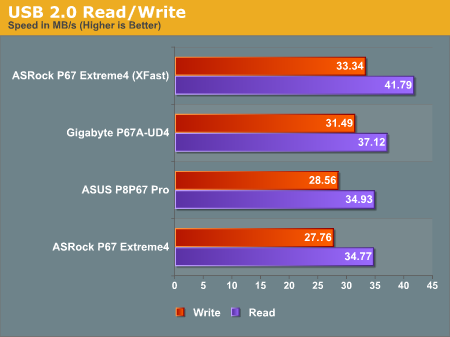
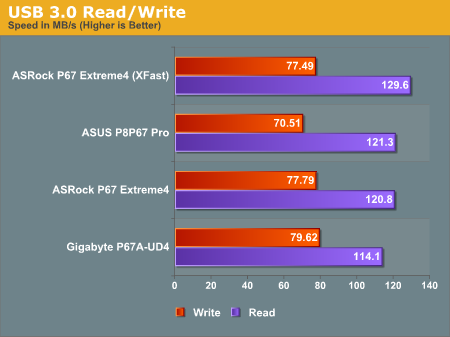
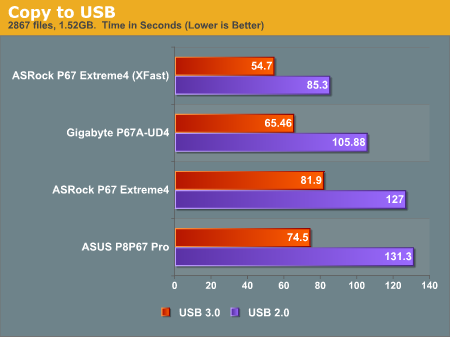
The Gigabyte board overall has the better USB performance, especially in USB 3.0 read speeds. This is accurately translated by the difference in copy time difference between the ASUS and Gigabyte boards in both USB 2.0 and USB 3.0.
3D Movement Algorithm Test
The first benchmark ran is actually one I have written. My full time job involves computational chemistry, so this first benchmark uses various algorithms for three-dimensional simulation and movement of independent particles. The algorithms both employ uniform random number generation or normal distribution random number generation, and vary in various amounts of trigonometric operations, conditional statements, generation and rejection, fused operations, etc. The benchmark runs through six algorithms for a specified number of particles and steps, and calculates the speed of each algorithm, then sums them all for a final score. This is an example of a real world situation that a computational scientist may find themselves in, rather than a pure synthetic benchmark. The benchmark is also parallel between particles simulated, and we test the single thread performance as well as the multi-threaded performance.

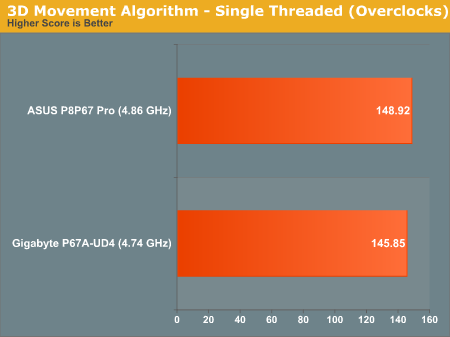
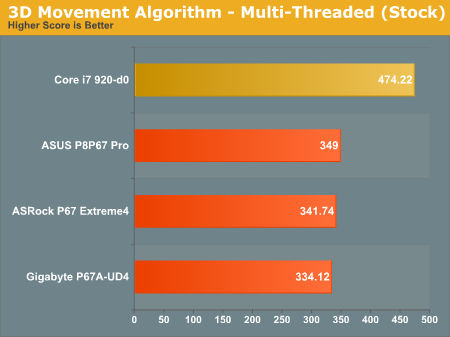
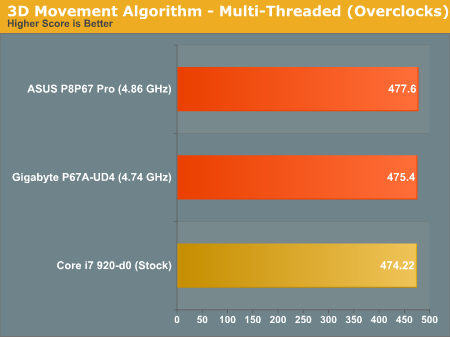
There's barely anything between the boards. The Core i7-920 pulls ahead at stock as it has 8 threads to tackle the workload, whereas the i5-2500K used in the P67 motherboards only has four.
WinRAR x64 3.93
With 64-bit WinRAR, we compress the set of files used in the USB speed tests. WinRAR x64 3.93 attempts to use multithreading when possible.
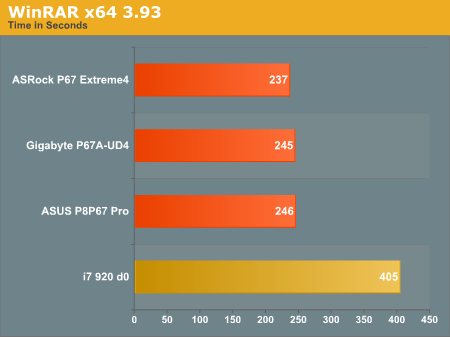
FastStone Image Viewer 4.2
FastStone Image Viewer is a free piece of software I have been using for quite a few years now. It allows quick viewing of flat images, as well as resizing, changing color depth, adding simple text or simple filters. It also has a bulk image conversion tool, which we use here. The software currently operates only in single-thread mode, which should change in later versions of the software. For this test, we convert a series of 170 files, of various resolutions, dimensions and types (of a total size of 163MB), all to the .gif format of 640x480 dimensions.
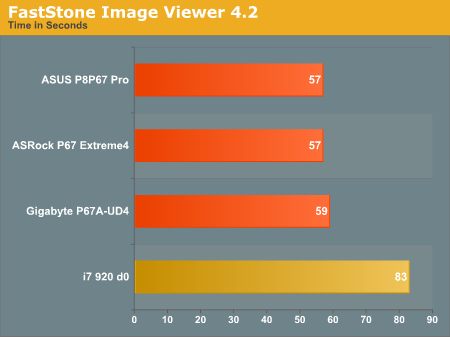
Sorenson Squeeze 6.0
Sorenson Squeeze is a professional video encoder, complete with a vast array of options. For this test, we convert 32 HD videos, each a minute long and approximately 42 MB in size, to WMV 512KBps format. Squeeze can encode multiple videos at once, one for each thread.
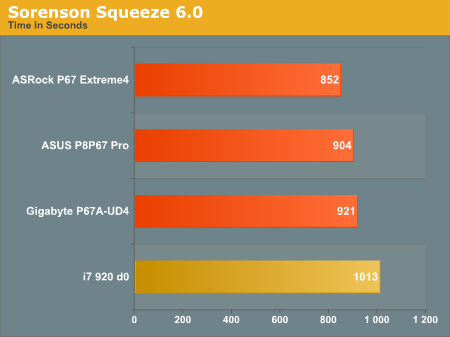
Conclusions
There is not much in it, but the ASUS board performs better in most benchmarks with one exception - the USB speed (especially the USB 3.0 read) is a step behind the Gigabyte.










137 Comments
View All Comments
IanCutress - Thursday, January 20, 2011 - link
Long term usability isn't something that's easily tested. Sleep and hibernate is simple to test, but leaving the board on for a week? We unfortunately a) do not have enough hardware to keep the mu;tiples of same test bed and test other products at the same time, and b) if something did go wrong after a long sleep state, how long it would take to get in a different BIOS and re-run the test, or if a new BIOS had been released during the test, the test would have to be restarted. It's not a case of this being ignored by review sites, it's just not an applicable use of time, effort, and sustainability. If this is a major concern to you, then I'd suggest holding back until the next revisions of these boards hit the shelves - by that point, issues would be worked out and there would be a plethora of threads on the vendor's website describing various long term usability issues. There are always niche situations which could be looked at in more detail, and if you're up to the task, join a review website or start your own to tackle these issues specifically.Ian
strikeback03 - Friday, January 21, 2011 - link
Not to say your experiences are isolated (as I have an ASUS board that doesn't like one peripheral when resuming from sleep) but Gigabyte boards can have problems as well. I built a system for work using a P45 Gigabyte board that cannot run for more than 4 days, it just locks up after that.scott967a - Thursday, January 20, 2011 - link
Could you throw an MSI board into the mix?VahnTitrio - Thursday, January 20, 2011 - link
I had to order that ASUS board with basically no reviews available. Looks like I made a solid choice, as I got it for $165. I'm hoping it's waiting for me when I get home from work.landerf - Thursday, January 20, 2011 - link
Does anyone have a break down of what usb/sata controllers each asus model uses?ValueDriven - Thursday, January 20, 2011 - link
Thank you for this article. For me very timely w.r.t. general sandy bridge and ASUS specifically.I recently grabbed an i5-2500K at Microcenter for $192 after-tax, and bundled with an ASUS P8P67 (not PRO, Crossfire only) for another $127 after-tax. For a total of $320. Now all I need is some DDR3 memory and I'll have the missing components for my new build (non-gamer). So for about $375-$400, I'll have for once the basis of a mid-level enthusiast build with the latest technology and over-clockable in the high 4-5GHz range. (I usually trail the technology, letting it "depreciate." Hence, ValueDriven.)
I've had mixed results, but generally good, with ASUS boards. Long ago I had an ASUS P2B-F (i486 I think, PENTIUM III - 750MHz) which seemed pretty good and lasted a long long time.
Next I had an ASUS A7N8X Deluxe (AMD Athlon) board which was OK, although it did finally fail. I only hated it relative to the ABIT NF-7S board I got for a 2nd setup which oc'd a lot better, taking my Athlon from a native 1460MHz up to about 2220MHz..
Most recently I have an ASUS P5 Deluxe WiFi-AP (with a Core2 Quad 6600) which I got on clearance when CompUSA folded (to become kids 'puter). I really can't complain about this board. In fact, it has been great. The only thing it hasn't done is oc my Q6600 as high as I'd like, but I believe this is the fault of my TUNIQ Tower120 which has a crappy mount (press fit screw retainer heads popped off during installation - requiring torch & hammer repair). If I keep this Q6600 setup, I'll probably install a new heatsink...maybe a SCYTHE Mugen 2 w/ double fans which is sitting in the closet. But then I need to get a cooler for the i5-2500k! :(
The only GIGABYTE board I have, a GA-EP45-UD3R, I have never used. I bought it and an INTEL Q9550 for a new build which I'm probably going to skip & resell the parts. But I did buy it b/c I had heard good things about this board. (Mugen was originally for this setup.)
SO for me the real question is: Is it better to keep the Sandy Bridge setup & part out either my unused Q9550 setup or my used Q6600 setup, OR is it better to return the Sandy Bridge and just build my Q9950? The jury is still out!
darckhart - Thursday, January 20, 2011 - link
It's not really value driven if you don't use the parts you buy... it's just a loss. that continues to depreciate.wrt your situation, move forward with the sandy bridge since you have it already. at 4.5+ GHz, and new board features like usb3 etc, it's already loads better than a q9550 oc and p45 chipset.
strikeback03 - Friday, January 21, 2011 - link
I'd have to check, but I believe that is the same processor and motherboard I referenced above. In which case I couldn't recommend it unless you naturally shut the computer down daily or similar. We have it set up next to a stock-clock Q6600/P35 system and the student using them says the Q9550 feels faster, that said if overclocking you probably won't be able to tell much of a difference and the newer parts would probably get you more money back. the i5 is going to be a lot faster.DaveSimmons - Thursday, January 20, 2011 - link
Do any of the three support Dolby Digital Live real-time encoding of game audio as 5.1 for the optical digital port?I'm using analog outs for my socket775 system but may be switching to optical digital for my next build.
ajp_anton - Thursday, January 20, 2011 - link
You should've benchmarked the LAN connection. Is there any difference between Intel and Realtek?